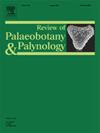Palaeoenvironmental response to the Early Cretaceous volcanic ash fall: Evidence from palynology and palynofacies of the tonstein-bearing coal seam of Kharanor Deposit, Transbaikalia, Russia
IF 1.7
3区 地球科学
Q2 PALEONTOLOGY
引用次数: 0
Abstract
Volcanic ash falls, being one of the consequences of eruptive palaeoevents, are reflected in the geological record of coal-bearing sediments as tonsteins, thin clayey interlayers. Information on the palaeontological characteristics of tonsteins and assessments of the influence of ash on the palaeoenvironment are still fragmentary. This paper presents new palynological and palynofacies data obtained for the tonstein-bearing Kharanor coal deposit located in Transbaikalia, Russia. The spore and pollen assemblages indicate the early Albian (Cretaceous) age of the sediments. The tonstein palynomorph composition differs markedly from the host coal one, which is expressed in an increased number of fern spores and a decreased content of gymnosperm pollen. The palynofacies composition of the Kharanor tonstein is characterised by a high content of phytoclasts of the cutinite subgroup and an increased content of palynomorphs and amorphous organic matter, whereas the lower and upper coals are dominated by vitrinite and inertinite phytoclasts. The results indicate peat-forming conditions that existed in a swampy area where a predominantly gymnosperm-fern forest grew in a wet and warm-temperate climate. At one point the area was covered by a relatively thick layer of volcanic ash, resulting in the burial of the lower forest layers, possibly during their spore production period. Rapid rates of sedimentation and subsequent compaction resulted in the conservation of organic matter, including unstable soft plant tissues. However, the impact of the volcanic event on vegetation and palaeoenvironment had a noticeable but short-term effect. No fundamental changes in flora or sedimentation conditions followed in the long term.
早白垩世火山灰沉降的古环境响应:来自俄罗斯外贝加尔地区Kharanor矿区含铜煤层孢粉学和孢粉相的证据
火山灰落体是火山喷发古事件的结果之一,在含煤沉积物的地质记录中反映为薄粘土夹层。关于火山的古生物学特征和火山灰对古环境影响的评估的资料仍然是零碎的。本文介绍了俄罗斯外贝加尔地区含铜矿区Kharanor煤矿的孢粉学和孢粉相新资料。孢子和花粉组合表明沉积物的早白垩纪时代。其孢粉组成与寄主煤的孢粉组成明显不同,表现为蕨类孢子数量增加,裸子植物花粉含量减少。其孢粉相组成以高含量的角质质亚群植物碎屑为主,孢粉质和无定形有机质含量增加,而下部和上部煤则以镜质组和惰质组植物碎屑为主。结果表明,泥炭形成条件存在于沼泽地区,在潮湿和温暖的气候中,主要生长着裸子植物-蕨类森林。该地区一度被一层相对较厚的火山灰覆盖,导致较低的森林层被掩埋,可能是在它们产生孢子的时期。快速的沉积速率和随后的压实导致了有机物的保存,包括不稳定的软植物组织。然而,火山事件对植被和古环境的影响是明显的,但短期的。长期以来,植物群或沉积条件没有发生根本变化。
本文章由计算机程序翻译,如有差异,请以英文原文为准。
求助全文
约1分钟内获得全文
求助全文
来源期刊
CiteScore
3.50
自引率
21.10%
发文量
149
审稿时长
6 months
期刊介绍:
The Review of Palaeobotany and Palynology is an international journal for articles in all fields of palaeobotany and palynology dealing with all groups, ranging from marine palynomorphs to higher land plants. Original contributions and comprehensive review papers should appeal to an international audience. Typical topics include but are not restricted to systematics, evolution, palaeobiology, palaeoecology, biostratigraphy, biochronology, palaeoclimatology, paleogeography, taphonomy, palaeoenvironmental reconstructions, vegetation history, and practical applications of palaeobotany and palynology, e.g. in coal and petroleum geology and archaeology. The journal especially encourages the publication of articles in which palaeobotany and palynology are applied for solving fundamental geological and biological problems as well as innovative and interdisciplinary approaches.

 求助内容:
求助内容: 应助结果提醒方式:
应助结果提醒方式:


